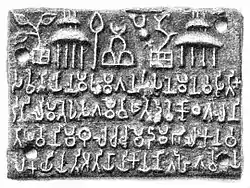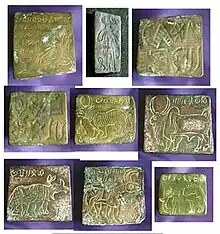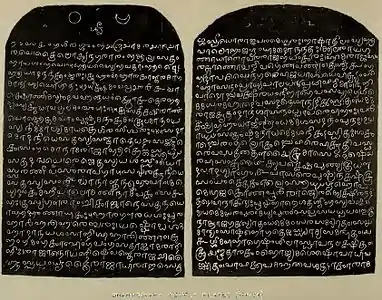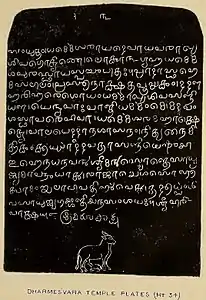Indian copper plate inscriptions
Indian copper plate inscriptions are historical legal records engraved on copper plates in the Indian subcontinent.[1]
Donative inscriptions engraved on copper plates, often joined by a ring with the seal of the donor, was the legal document registering the act of endowment. It was probably necessary to produce them when required to prove ownership/ the claim to the rights.[1] The retrievability of the copper plates was perhaps crucial in the newly settled lands.[2] Detailed information on land tenures and taxation available from these copper plate grants.[1]
History

Indian copper plate inscriptions (tamarashasana), usually record grants of land or lists of royal lineages carrying the royal seal, a profusion of which have been found in South India. Originally inscriptions were recorded on palm leaves, but when the records were legal documents such as title-deeds they were etched on a cave or temple wall, or more commonly, on copper plates which were then secreted in a safe place such as within the walls or foundation of a temple, or hidden in stone caches in fields. Plates could be used more than once, as when a canceled grant was over-struck with a new inscription. These records were probably in use from the first millennium.

A group of nine inscribed copper plates has been identified by Shinde in 2014 as the oldest such objects in the Indian subcontinent. They date to the Mature Harappan era, and contain inscriptions up to 34 characters long. Place of origin unknown. They are thought to have been used for copper plate printing.[3]
The so-called Sohgaura copper-plate inscription, inscribed in the Brahmi script, and is possibly from the 3rd century BCE Maurya Empire, is a precursor to the later copper-plate inscriptions.[4] However, it is actually written on a small plaque of bronze (a copper alloy).[5] The Taxila and the Kalawan copper-plate inscriptions (c. 1st century CE or earlier) are among the earliest known instances of copper plates being used for writing in the Indian subcontinent. However, these are not proper charters, unlike the later copper-plate inscriptions.[6]
The oldest known copper-plate charter from the Indian subcontinent is the Patagandigudem inscription of the 3rd century CE Andhra Ikshvaku king Ehuvala Chamtamula. The oldest known copper-plate charter from northern India is probably the Kalachala grant of Ishvararata, dated to the late fourth century on palaeographic basis.[7]
Some of the earliest authenticated copper plates were issued by the Pallava dynasty kings in the 4th century, and are in Prakrit and Sanskrit. An example of early Sanskrit inscription in which Kannada words are used to describe land boundaries, are the Tumbula inscriptions of Western Ganga Dynasty, which have been dated to 444 according to a 2004 Indian newspaper report.[8] Rare copper plates from the Gupta period have been found in North India. The use of copper plate inscriptions increased and for several centuries they remained the primary source of legal records.[9]
Most copper plate inscriptions record title-deeds of land-grants made to Charanas and Brahmanas, individually or collectively. The inscriptions followed a standard formula of identifying the royal donor and his lineage, followed by lengthy honorifics of his history, heroic deeds, and his extraordinary personal traits. After this would follow the details of the grant, including the occasion, the recipient, and the penalties involved if the provisions were disregarded or violated. Although the profusion of complimentary language can be misleading, the discovery of copper plate inscriptions have provided a wealth of material for historians.[9][10][11][12]
Tirumala Venkateswara Temple have a unique collection of about 3000 copper plates on which the Telugu Sankirtans of Tallapaka Annamacharya and his descendants are inscribed.[13]
Tamil copper-plate inscriptions
Tamil copper-plate inscriptions are engraved copper-plate records of grants of villages, plots of cultivable lands or other privileges to private individuals or public institutions by the members of the various South Indian royal dynasties.[14] The study of these inscriptions has been especially important in reconstructing the history of Tamil Nadu.[15] The grants range in date from the 10th century C.E. to the mid 19th century C.E. A large number of them belong to the Chalukyas, the Cholas and the Vijayanagar kings. These plates are valuable epigraphically as they give us an insight into the social conditions of medieval South India; they also help us fill chronological gaps in the connected history of the ruling dynasties. For example, the Leyden grant (so called as they are preserved in the Museum of Leyden in Holland) of Parantaka Chola and those of Parakesari Uttama Chola are among the most important, although the most useful part, i.e., the genealogical section, of the latter's plates seems to have been lost.
- Vijaynagar Tamil Copper Plate Inscriptions at the Dharmeshwara Temple, Kondarahalli, Hoskote
 Plate 1 and Back
Plate 1 and Back Plate 2[16]
Plate 2[16]
Unlike the neighbouring states where early inscriptions were written in Sanskrit and Prakrit, the early inscriptions in Tamil Nadu used Tamil [17] along with some Prakrit. Tamil has the extant literature amongst the Dravidian languages, but dating the language and the literature precisely is difficult. Literary works in India were preserved either in palm leaf manuscripts (implying repeated copying and recopying) or through oral transmission, making direct dating impossible.[18] External chronological records and internal linguistic evidence, however, indicate that extant works were probably compiled sometime between the 4th century BCE and the 3rd century CE.[19][20][21] Epigraphic attestation of Tamil begins with rock inscriptions from the 3rd century BCE, written in Tamil-Brahmi, an adapted form of the Brahmi script.[22][23] The earliest extant literary text is the Tolkāppiyam, a work on poetics and grammar which describes the language of the classical period, dated variously between the 5th century BCE and the 2nd century CE.
Copper plates of Kerala
Between the eighth and tenth centuries, rulers on the Malabar Coast awarded various rights and privileges to Nazranies (Saint Thomas Christians) on copper plates, known as Cheppeds, or Royal Grants or Sasanam.[24]
_plates_1_and_4.jpg.webp) Tharisapalli plates of 849 CE
Tharisapalli plates of 849 CE.png.webp) The inscription from the Sasanam
The inscription from the Sasanam
- Iravikorthan Sassanam, awarded by Shri Veera Raghava Perumal (in c. 774 CE)
- Thomas of Cana copper plates, a lost set of copper plates awarded to Knai Thoma and his followers (Knanaya) sometime between the 4th and 9th century.
- Tharissapalli Chepped, awarded in 849 CE by the King of Venadu (Quilon), Ayyan Atikal Tiruvatikal, to Sapir Isho, the leader of Syrian Christians in Malabar Coast in the 5th regnal year of the Chera ruler Sthanu Ravi Varma. It is the first important inscription of Kerala, the date of which has been determined with accuracy.[25][26][27] It is engraved on copper plates in vatteluttu and signed by 25 witnesses. Names of fifteen of them are in Kufic, ten in Pahlavi, and four in Hebrew.
- Jewish Copper Plate, awarded by Bhaskara Ravi Varman I Perumal (962-1019 A.D.), is a Sasanam outlining the grant of rights of the Anjuvannam and 72 other properietary rights to local Jewish Chief Ousepp Irabban
Grants

One of the most important sources of history in the Indian subcontinent are the royal records of grants engraved on copper-plates (tamra-shasan or tamra-patra; tamra means copper in Sanskrit and several other Indian languages). Because copper does not rust or decay, they can survive virtually indefinitely.
Collections of archaeological texts from the copper-plates and rock-inscriptions have been compiled and published by the Archaeological Survey of India during the past century.
Approximate dimensions of copper plate is 93⁄4 inch long × 31⁄4 inch high × 1/10 (to 1/16) inch thick.
The earliest known copper-plate, known as the Sohgaura copper-plate, is a Maurya record that mentions famine relief efforts. It is one of the very few pre-Ashoka Brahmi inscriptions in India.[28]
See also
References
- Thapar, Romila, The Penguin History of Early India: From the Origins to AD 1300. Penguin Books, 2002. 295-96 and 339.
- Thapar, Romila, The Penguin History of Early India: From the Origins to AD 1300. Penguin Books, 2002. 409.
- Shinde, Vasant; Willis, Rick J. (8 October 2014). "A New Type of Inscribed Copper Plate from Indus Valley (Harappan) Civilisation". Ancient Asia. 5. doi:10.5334/aa.12317.
- F. R. Allchin; George Erdosy (1995). The Archaeology of Early Historic South Asia: The Emergence of Cities and States. Cambridge University Press. pp. 212–215. ISBN 978-0-521-37695-2.
- D. C. Sircar 1996, p. 79.
- D. C. Sircar 1996, p. 107.
- Emmanuel Francis (2018). "Indian Copper-Plate Grants: Inscriptions or Documents?". In Alessandro Bausi; Christian Brockmann; Michael Friedrich; Sabine Kienitz (eds.). Manuscripts and Archives: Comparative Views on Record-Keeping. De Gruyter. p. 389. ISBN 978-3-11-054139-7.
- N. Havalaiah (2004-01-24). "Ancient inscriptions unearthed". The Hindu. Chennai, India. Archived from the original on 2004-02-18. Retrieved 2006-11-25.
- Keay, John (2000). India: A History. New York: Grove Press. pp. 155–157. ISBN 0-8021-3797-0.
- "Nature and Importance of Indian Epigraphy". Archived from the original on 2007-09-28. Retrieved 2007-03-16.
- Trikha, Madhav Hada Translated by Pradeep (2020-12-07). Meera Vs Meera. Vani Prakashan. ISBN 978-93-89915-90-7.
...medieval period in Mewar, about twelve percent of the land went into the hands of Brahmins and Charans. Their villages were now regarded as the tamba-patra (the State order issued on the copper plate) villages and were exempted from revenue...
- Kumar, Vijay (1991). British Paramountcy in Rajputana: A Case Study of Relation of the Sirohi State with the British, 1823-1905 A.D. Books Treasure.
The 'Sasan' lands were granted to temples and members of certain castes such as Brahmans ,Charans...They were for all practical purposes in perpetuity and were held rent free. Usually the ancient practice of issuing a copper plate, on which the conditions of grant, the names of the grantor and grantee were engraved was given to the grantee.
- Epigraphical lore of Tirupati published in Saptagiri magazine. Archived 2003-02-16 at the Wayback Machine
- "Nature and Importance of Indian Epigraphy - Chapter IV". Archived from the original on 2007-09-28. Retrieved 2007-03-14.
- "History and Culture of Tamil Nadu : As Gleaned from the Sanskrit Inscriptions". Retrieved 2007-03-14.
- Rice, Benjamin Lewis (1894). Epigraphia Carnatica: Volume IX: Inscriptions in the Bangalore District. Mysore State, British India: Mysore Department of Archaeology. Retrieved 5 August 2015.
- Caldwell, Robert (1875). A comparative grammar of the Dravidian or South-Indian family of languages. Trübner & co. pp. 88.
In southern states, every inscription of an early date and majority even of modern-day inscriptions were written in Sanskrit...In the Tamil country, on the contrary, all the inscriptions belonging to an early period are written in Tamil with some Prakrit
- Dating of Indian literature is largely based on relative dating relying on internal evidences with a few anchors. I. Mahadevan’s dating of Pukalur inscription proves some of the Sangam verses. See George L. Hart, "Poems of Ancient Tamil, University of Berkeley Press, 1975, p.7-8
- George Hart, "Some Related Literary Conventions in Tamil and Indo-Aryan and Their Significance" Journal of the American Oriental Society, 94:2 (Apr-Jun 1974), pp. 157-167.
- Kamil Veith Zvelebil, Companion Studies to the History of Tamil Literature, pp12
- Nilakanta Sastri, K.A. (1955). A History of South India, OUP, New Delhi (Reprinted 2002)
- "Tamil". The Language Materials Project. UCLA International Institute, UCLA. Archived from the original on 2007-10-11. Retrieved 2007-03-25.
- Iravatham Mahadevan (2003). Early Tamil Epigraphy from the Earliest Times to the Sixth Century A.D. Cambridge, Harvard University Press.
- SG Pothen. Syrian Christians of Kerala (1970). p. 32-33.
- A. Sreedhara Menon. Kerala History (1999). p.54.
- N.M. Mathew History of the Marthoma Church (Malayalam), Volume I. p. 105-109.
- Cheriyan, Dr. C.V. Orthodox Christianity in India. p. 85, 126, 127, 444-447.
- Thapar, Aśoka and the Decline of the Mauryas,2014, pp. 10
Bibliography
- D. C. Sircar (1996). Indian Epigraphy. Motilal Banarsidass. ISBN 978-81-208-1166-9.